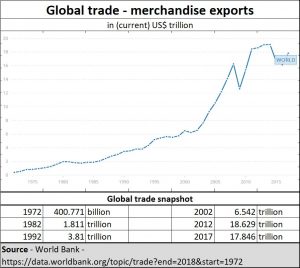https://www.freepressjournal.in/cmcm/chinas-white-paper-on-the-us-tariff-spat
China-US spat threatens global trade
RN Bhaskar – June 6, 2019
In 2017, China trounced Canada to become the second largest trading partner with the US. US-China trade accounted for 635 billion against $582 billion for US-Canada trade.
But then Donald Trump became President of the US, and global trade which peaked in 2014 began taking a more severe beating than ever before. Global merchandise trade shrank to 17.85 trillion in 2017 (see chart) and is expected to shrink even further, rather precipitously, especially after the onset of the US-China trade spat.
 On 2 June 2019, China finally decided to come out with a white paper on its position on the tariff war between itself and the US. The document, brought out by the State Council Information Office of The People’s Republic of China is titled with a white paper titled “China’s Position on the China-US Economic and Trade Consultations” (http://www.xinhuanet.com/english/2019-06/02/c_138110404.htm and http://www.xinhuanet.com/english/download/20190602fulltext.doc). It explains how the broken trade negotiations will only harm the interests of both countries and even the world. .
On 2 June 2019, China finally decided to come out with a white paper on its position on the tariff war between itself and the US. The document, brought out by the State Council Information Office of The People’s Republic of China is titled with a white paper titled “China’s Position on the China-US Economic and Trade Consultations” (http://www.xinhuanet.com/english/2019-06/02/c_138110404.htm and http://www.xinhuanet.com/english/download/20190602fulltext.doc). It explains how the broken trade negotiations will only harm the interests of both countries and even the world. .
As the white paper puts it, “The China-US commercial relationship serves as both the ballast and the propeller of the overall bilateral relationship. At stake are the fundamental interests of the two peoples, and the prosperity and stability of the world.”.
The paper puts the blame squarely on the new US administration ever since it took office in 2017. This administration, states the paper, has “threatened additional tariffs and other measures and provoked frequent economic and trade friction with its major trading partners.”
It points out how China had to “take forceful measures to defend the interests of the nation and its people” in response to the economic and trade friction unilaterally initiated by the US unilaterally since March 2018.
China believes that its position right from the start has “been consistent and clear” that disputes must be resolved through dialogue and consultation. “Cooperation serves the interests of the two countries, that conflict can only hurt both, and that cooperation is the only correct choice for both sides.” But it also adds that cooperation has to be based on principles. There are bottom lines in consultations, it adds. China will not compromise on major issues of principle.
China, it said, does not want a trade war, but it is not afraid of one and it will fight one if necessary
The paper points to the manner in which two-way trade between the US and China swelled 252 times from $2.5 billion in 1979 to $633.5 billion in 2018. China was the key export market for US airplanes, soybeans, automobiles, integrated circuits and cotton.
Even two-way trade in services rose from US$27.4 billion in 2006, the earliest year with available statistics, to US$125.3 billion in 2018, a 3.6-fold increase.
But the tariff war – declared unilaterally by the US — could undo all this. In this context it may be stated that the US has often done things unilaterally, without heed to global opinion. It unilaterally broke the nuclear deal with Iran, it invaded Iraq (read Harold Pinter’s critique on the US action at https://www.theguardian.com/stage/2005/dec/08/theatre.nobelprize). It unilaterally abetted the fall of Libya, and the snactions on Iran. Just last week, it decided to end the GSP regime it has had with India.
This trade war will have four major consequences.
First, says the report, the tariff measures have significantly increased production costs for US companies.
Secondly, the tariff measures will lead to – even if they haven’t already — domestic price hikes in the US. According to research by the US National Retail Federation, the 25 percent additional tariffs on furniture alone will cost the US consumer an additional US$4.6 billion per year.
Thirdly the tariff measures have an impact on US economic growth and people’s livelihoods. A joint report by the US Chamber of Commerce and the Rhodium Group in March 2019 showed that, under the impact of China-US economic and trade friction, US GDP in 2019 and the next four years could decrease by US$64-91 billion per year, about 0.3-0.5 percent of total US GDP. The US could lose 2.16 million jobs.
Fourthly, the tariff measures lead to barriers to US exports to China. The 2019 State Export Report, published by the US-China Business Council on May 1, 2019, stated that in the ten years from 2009 to 2018, US exports to China supported over 1.1 million jobs.
The trade war could harm the entire world as well by undermining the authority of the multilateral trading system. It could threaten global economic growth at a time when an economic slowdown is already in evidence, and push the world economy into a “recession trap”. It could severely disrupt global industrial and supply chains.





































COMMENTS